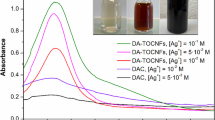Abstract
CO2-derived succinate production was enhanced by Actinobacillus succinogenes through polystyrene (PSt) microsphere materials for CO2 adsorption in bioreactor, and the adhesion forces between A. succinogenes bacteria and PSt materials were characterized. Synthesized uniformly sized and highly cross-linked PSt microspheres had high specific surface areas. After modification with amine functional groups, the novel amine-functionalized PSt microspheres exhibited a high adsorption capacity of 25.3 mg CO2/g materials. After addition with the functionalized microspheres into the culture broth, CO2 supply to the cells increased. Succinate production by A. succinogenes can be enhanced from 29.6 to 48.1 g L−1. Moreover, the characterization of interaction forces between A. succinogenes cells and the microspheres indicated that the maximal adhesive force was about 250 pN. The amine-functionalized PSt microspheres can adsorb a large amount of CO2 and be employed for A. succinogenes anaerobic cultivation in bioreactor for high-efficiency production of CO2-derived succinate.



Similar content being viewed by others
References
Adamczyk, M., Lasek, J., & Skawińska, A. (2016). CO2 biofixation and growth kinetics of Chlorella vulgaris and Nannochloropsis gaditana. Applied Biochemistry and Biotechnology. doi:10.1007/s12010-016-2062-3.
Wang, C., Zhang, H. L., Cai, H., Zhou, Z. H., Chen, Y. L., Chen, Y. L., & Ouyang, P. K. (2014). Succinic acid production from corn cob hydrolysates by genetically engineered Corynebacterium glutamicum. Applied Biochemistry and Biotechnology, 172, 340–350.
Chen, Y., & Nielsen, J. (2016). Biobased organic acids production by metabolically engineered microorganisms. Current Opinion in Biotechnology, 37, 165–172.
Salvachúa, D., Mohagheghi, A., Smith, H., Bradfield, M. F., Nicol, W., Black, B. A., Biddy, M. J., Dowe, N., & Beckham, G. T. (2016). Succinic acid production on xylose-enriched biorefinery streams by Actinobacillus succinogenes in batch fermentation. Biotechnology for Biofuels, 9, 28.
Song, H., Lee, J. W., Choi, S., You, J. K., Hong, W. H., & Lee, S. Y. (2007). Effects of dissolved CO2 levels on the growth of Mannheimia succiniciproducens and succinic acid production. Biotechnology and Bioengineering, 98, 1296–1304.
Chen, X., Sun, J., Wang, J. Q., & Cheng, W. G. (2012). Polystyrene-bound diethanolamine based ionic liquids for chemical fixation of CO2. Tetrahedron Letters, 53, 2684–2688.
Martín, C. F., Stöckel, E., Clowes, R., Adams, D. J., Cooper, A. I., Pis, J. J., Rubiera, F., & Pevida, C. J. (2011). Hypercrosslinked organic polymer networks as potential adsorbents for pre-combustion CO2 capture. Journal of Materials Chemistry, 21, 5475–5483.
Kaliva, M., Armatas, G. S., & Vamvakaki, M. (2012). Microporous polystyrene particles for selective carbon dioxide capture. Langmuir, 28, 2690–2695.
Zhang, C. X., Zhang, R. Y., Li, Q., Huang, Y. D., Zhao, L., Su, Z. G., Gong, F. L., Lv, Z., Song, H. Y., Li, W., Yuan, Q. P., & Ma, G. H. (2015). Rapid octreotide separation from synthetic peptide crude mixtures by chromatography on poly(styrene–co-divinylbenzene)-based reversed phases. Separation and Purification Technology, 154, 351–358.
An, D., Wu, L. B., Li, B. G., & Zhu, S. P. (2007). Synthesis and SO2 absorption/desorption properties of poly(1,1,3,3-tetramethylguanidine acrylate). Macromol., 69, 3388–3393.
Li, Q., Wang, D., Hu, G., Xing, J. M., & Su, Z. G. (2011). Integrated bioprocess for high-efficiency production of succinic acid in an expanded-bed adsorption system. Biochemical Engineering Journal, 56, 150–157.
Hofstadt, M. V. D., Hüttener, M., Juárez, A., & Gomila, G. (2015). Nanoscale imaging of the growth and division of bacterial cells on planar substrates with the atomic force microscope. Ultramicroscopy, 154, 29–36.
Hauser, I., Colaco, A. B., Skjæran, J. A., Einbu, A., Østgaard, K., Svendsen, H. F., & Cervantes, F. J. (2013). Biological N removal from wastes generated from amine-based CO2 capture: case monoethanolamine. Applied Biochemistry and Biotechnology, 169, 1449–1458.
Li, Q., Zhang, R. Y., Wu, D. X., Huang, Y. D., Zhao, L., Wang, D., Gong, F. L., Li, L., Qiu, H., & Ma, G. H. (2016). Cell-nanoparticle assembly fabricated for CO2 capture and in situ carbon conversion. J. CO2 Util., 13, 17–23.
Li, Q., Xing, J. M., Li, W. L., Liu, Q. F., & Su, Z. G. (2009). Separation of succinic acid from fermentation broth using weak alkaline anion exchange adsorbents. Industrial and Engineering Chemistry Research, 48, 3595–3599.
Choi, W., Kim, G., & Lee, K. (2012). Influence of the CO2 absorbent monoethanolamine on growth and carbon fixation by the green alga Scenedesmus sp. Bioresource Technology, 120, 295–299.
da Rosa, G. M., Moraes, L., Cardias, B. B., Souza, M. R. A. Z., & Costa, J. A. V. (2015). Chemical absorption and CO2 biofixation via the cultivation of Spirulina in semicontinuous mode with nutrient recycle. Bioresource Technology, 192, 321–327.
Sumida, K., Rogow, D. L., Mason, J. A., McDonald, T. M., Bloch, D. E., Herm, Z. R., Bae, T., & Long, J. R. (2012). Carbon dioxide capture in metal-organic frameworks. Chemical Reviews, 112, 724–781.
Shimoi, N., & Abe, D. (2015). Method for measuring the distribution of adhesion forces on continuous nanoscale protrusions using carbon nanofiber tip on a scanning probe microscope cantilever. ACS Applied Materials & Interfaces, 7, 13776–13781.
Acknowledgments
The National Natural Science Foundation of China (Grant No. 21206175) supported this work.
Author information
Authors and Affiliations
Corresponding authors
Electronic supplementary material
ESM 1
(DOCX 435 kb)
Rights and permissions
About this article
Cite this article
Zhu, W., Li, Q. & Dai, N. CO2 Biofixation of Actinobacillus succinogenes Through Novel Amine-Functionalized Polystyrene Microsphere Materials. Appl Biochem Biotechnol 181, 584–592 (2017). https://doi.org/10.1007/s12010-016-2233-2
Received:
Accepted:
Published:
Issue Date:
DOI: https://doi.org/10.1007/s12010-016-2233-2




